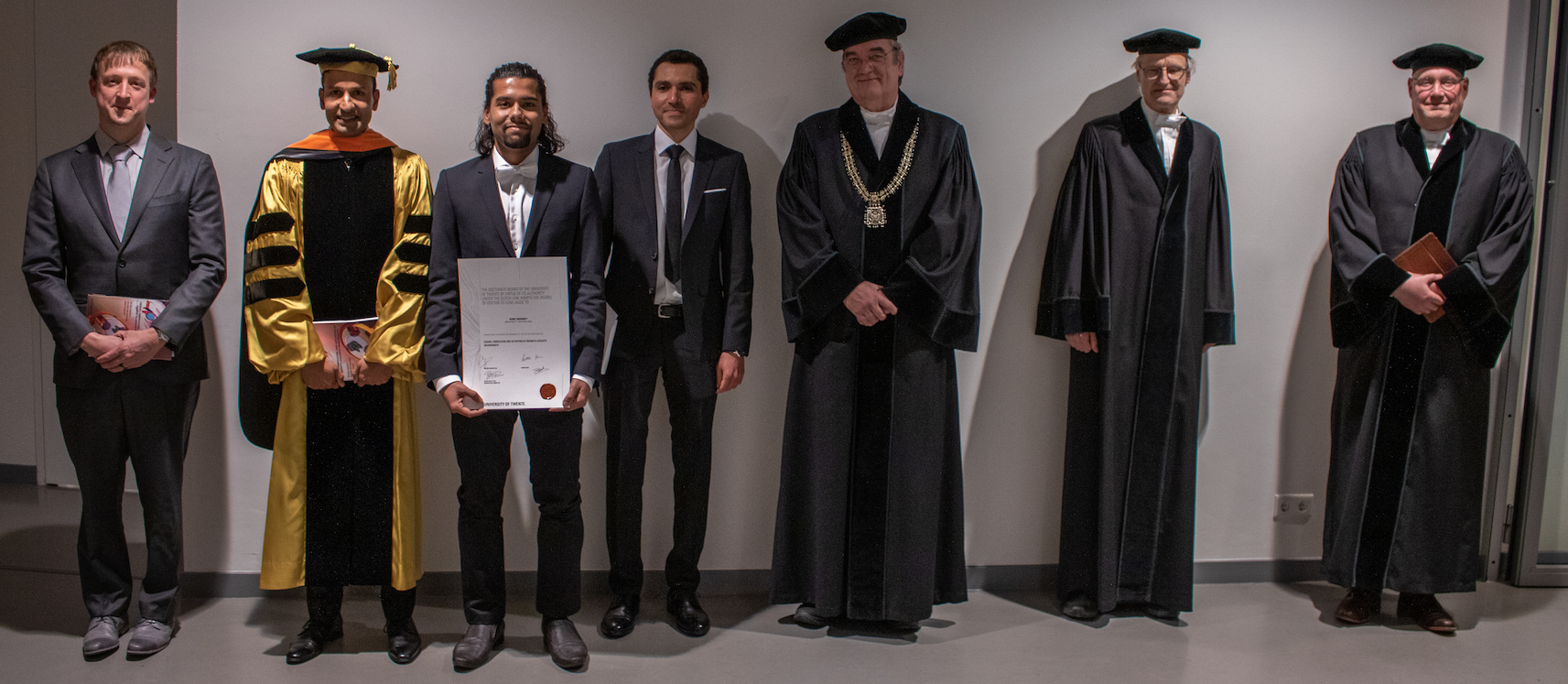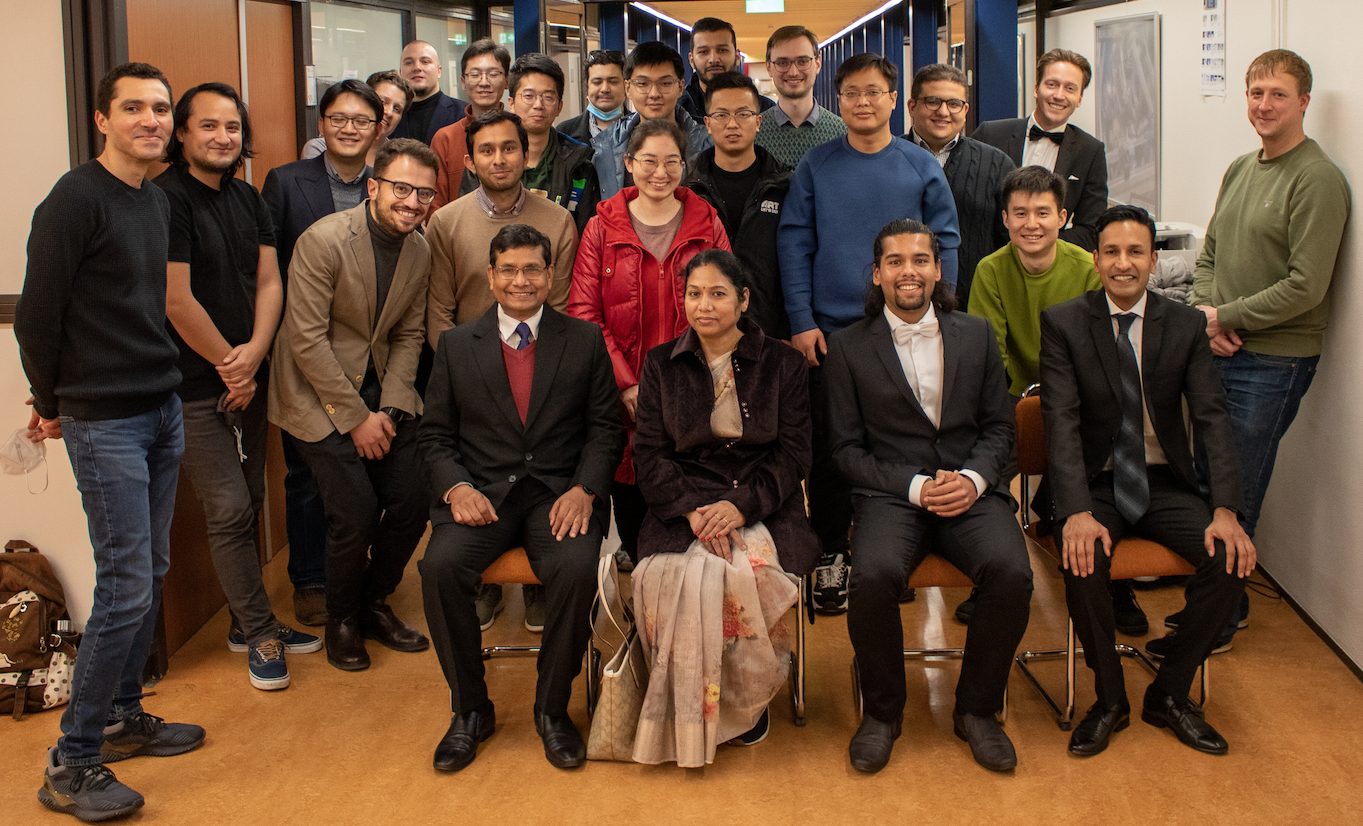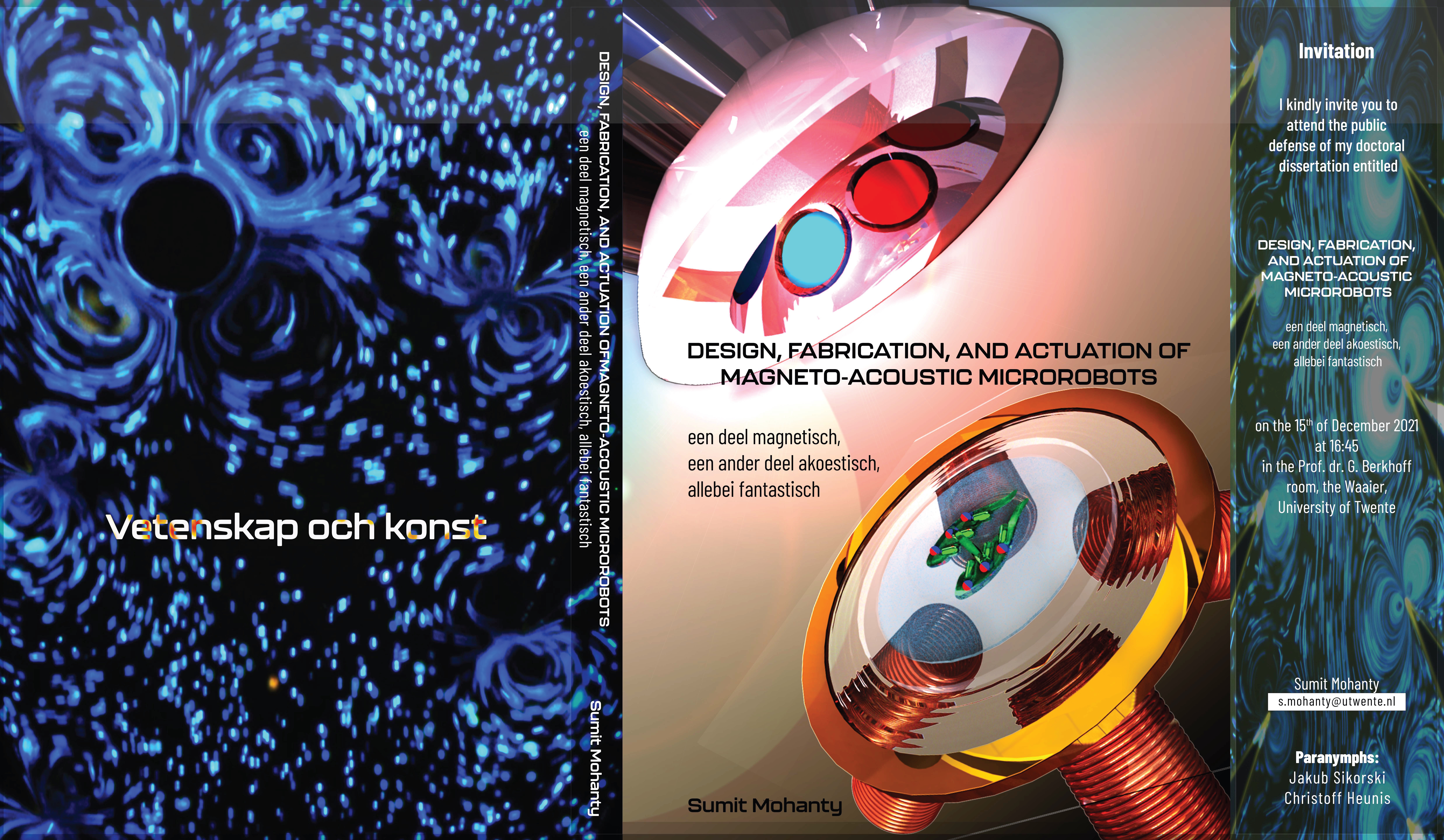
Doctoral defense – Sumit Mohanty
SRL doctoral candidate defends his thesis.
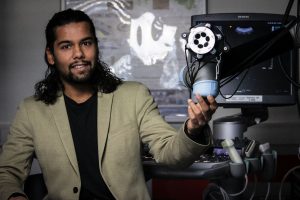 The defense of the doctoral thesis titled “Design, fabrication and actuation of magneto-acoustic microrobots” by Sumit Mohanty was held on Wednesday, 15th of December 2021 at 16:30 CET in the Prof. dr. G. Berkhoffzaal room, in the Waaier building at the University of Twente. Due to COVID-related audience restrictions, the defense was invite-only. Sumit graduated Cum Laude!
The defense of the doctoral thesis titled “Design, fabrication and actuation of magneto-acoustic microrobots” by Sumit Mohanty was held on Wednesday, 15th of December 2021 at 16:30 CET in the Prof. dr. G. Berkhoffzaal room, in the Waaier building at the University of Twente. Due to COVID-related audience restrictions, the defense was invite-only. Sumit graduated Cum Laude!
Thesis summary:
Bridging the fictional world of “Fantastic Voyage” to modern-day clinical applications, microrobots extend the outreach of minimally-invasive surgeries. Recent micromanipulation strategies have led to a plethora of microrobotic designs that remotely harvest energy from external sources. Such remote actuation empowers microrobots to perform various tasks in hard-to-reach environments such as biological vasculatures, microfluidic channels and cell cultures. Besides, these microrobots have the potential to replace large-scale mechanical instruments and make clinical procedures less invasive. However, there are considerable challenges in the synthesis and actuation of microrobots in order to be deployed for the aforementioned applications. Unlike macro-scale robots, microrobots cannot be easily tethered and powered with external peripheral electronics. Hence, microrobots derive energy from indirect physical forces (e.g., magnetism, acoustics, optics) or chemical reactions (e.g., peroxide decomposition, photocatalysis of noble metals, glucose oxidation) in order to move autonomously. The prevalence of existing clinical technologies like magnetic resonance and medical ultrasound imaging complement magnetics and acoustics, respectively, as indirect physical means of contactless manipulation.
 Among the two means of indirect actuation, magnetic actuation is the most popular approach employed to power microrobots. Inspired from the swimming mechanics of microorganisms (e.g., Escherichia coli, Spermatozoa, Spirulina platensis) countless designs of magnetically-powered microrobots have been reported over the past decade. Despite this popularity, it becomes challenging to design and fabricate different components of microrobots at micro- and nano-scale that move in response to magnetic forces. Moreover, various forms of magnetic actuation require heavy, bulky and power-consuming permanent or electromagnets as hardware. These hardware requirements often impose thermal constraints due to energy dissipation, or electrical bandwidth constraints which may limit speed of the applied actuation. In order to overcome these limitations, acoustic manipulation strategies are investigated as alternative means for contactless actuation of microrobots.
Among the two means of indirect actuation, magnetic actuation is the most popular approach employed to power microrobots. Inspired from the swimming mechanics of microorganisms (e.g., Escherichia coli, Spermatozoa, Spirulina platensis) countless designs of magnetically-powered microrobots have been reported over the past decade. Despite this popularity, it becomes challenging to design and fabricate different components of microrobots at micro- and nano-scale that move in response to magnetic forces. Moreover, various forms of magnetic actuation require heavy, bulky and power-consuming permanent or electromagnets as hardware. These hardware requirements often impose thermal constraints due to energy dissipation, or electrical bandwidth constraints which may limit speed of the applied actuation. In order to overcome these limitations, acoustic manipulation strategies are investigated as alternative means for contactless actuation of microrobots. 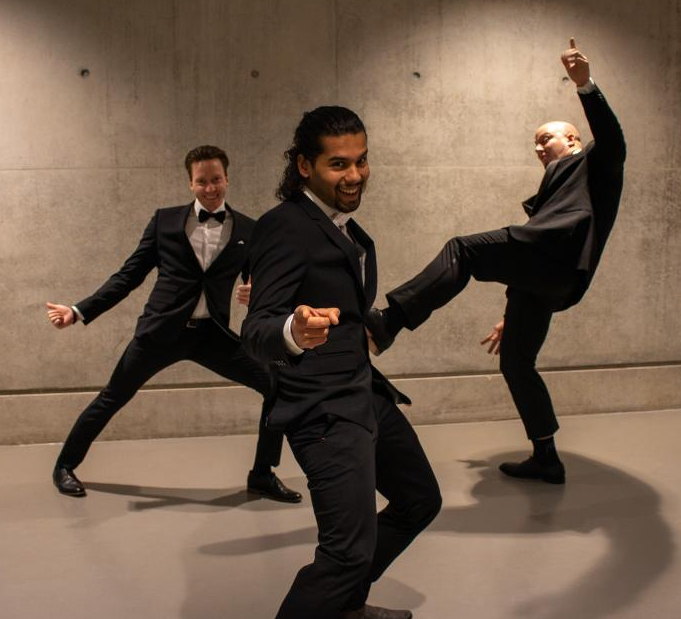 Particularly, the versatile nature of acoustic manipulation strategies benefits diverse scenarios that range from microfluidic- and levitation-based systems, to bubble-powered microrobots. Furthermore, acoustic microrobots can also collaborate with the traditional magnetic actuation and give rise to a hybrid magneto-acoustic micromanipulation strategy. This doctoral thesis describes a mix of magnetically- and acoustically-powered microrobots, and their respective actuation strategies. The chapters presented in this thesis embark the reader on a journey starting with the long-established magnetic microrobots, pass through different pit stops of acoustic microrobotic systems, and finally end where magnetic and acoustic microrobots join forces.
Particularly, the versatile nature of acoustic manipulation strategies benefits diverse scenarios that range from microfluidic- and levitation-based systems, to bubble-powered microrobots. Furthermore, acoustic microrobots can also collaborate with the traditional magnetic actuation and give rise to a hybrid magneto-acoustic micromanipulation strategy. This doctoral thesis describes a mix of magnetically- and acoustically-powered microrobots, and their respective actuation strategies. The chapters presented in this thesis embark the reader on a journey starting with the long-established magnetic microrobots, pass through different pit stops of acoustic microrobotic systems, and finally end where magnetic and acoustic microrobots join forces.
This doctoral thesis is divided into four parts and eight chapters that are entailed in the following manner. The thesis begins with a general introduction of the state-of-the-art in microrobotics, the challenges associated with different actuation methods and research questions to be addressed in subsequent chapters (Chapter 1). Following the 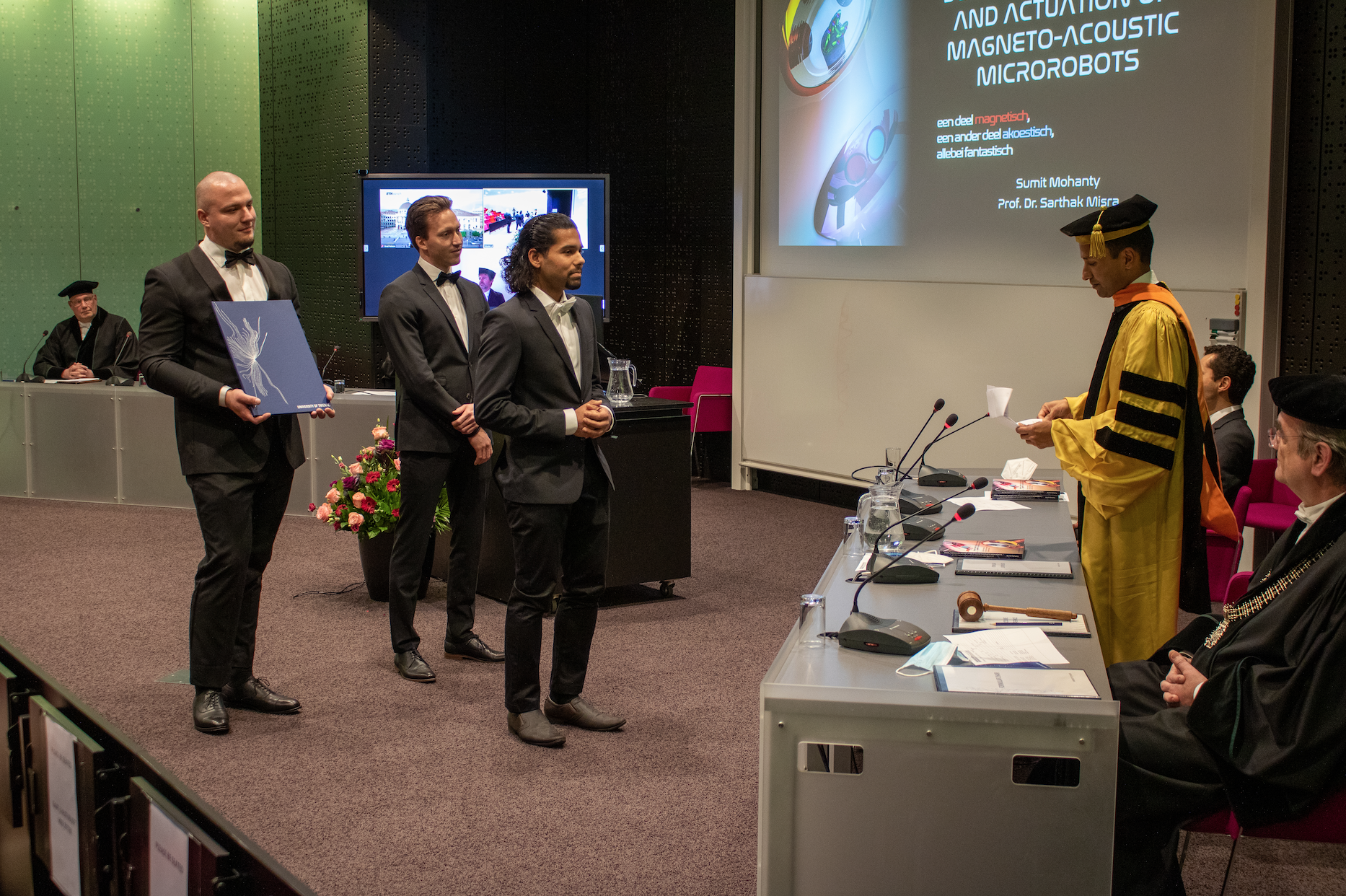 introduction, the most popular approach of magnetic actuation of microrobots is presented in Part I. In this part, the challenges faced by a majority of magnetic microrobots are addressed i.e., the ability of microrobots with similar magnetic property to exhibit independent motion (Chapter 2). Next, a wide variety of acoustic manipulation methods are introduced in Part II, starting with a survey that covers a global perspective of available acoustic actuation methods (Chapter 3). Here, these methods are categorized based on how sound waves travel along surfaces (lab-on-a-chip devices), or in bulk of the medium (steerable ultrasonic arrays). This categorization leads to two different application-specific microrobotic systems based on the aforementioned principles of acoustic propagation. First, an acoustically-powered microfluidic channel is presented as means to transport microrobots in these channels (Chapter 4). Second, an ultrasonic array (SonoTweezer) is developed for bulk manipulation of microrobots and its feasibility as an end-
introduction, the most popular approach of magnetic actuation of microrobots is presented in Part I. In this part, the challenges faced by a majority of magnetic microrobots are addressed i.e., the ability of microrobots with similar magnetic property to exhibit independent motion (Chapter 2). Next, a wide variety of acoustic manipulation methods are introduced in Part II, starting with a survey that covers a global perspective of available acoustic actuation methods (Chapter 3). Here, these methods are categorized based on how sound waves travel along surfaces (lab-on-a-chip devices), or in bulk of the medium (steerable ultrasonic arrays). This categorization leads to two different application-specific microrobotic systems based on the aforementioned principles of acoustic propagation. First, an acoustically-powered microfluidic channel is presented as means to transport microrobots in these channels (Chapter 4). Second, an ultrasonic array (SonoTweezer) is developed for bulk manipulation of microrobots and its feasibility as an end-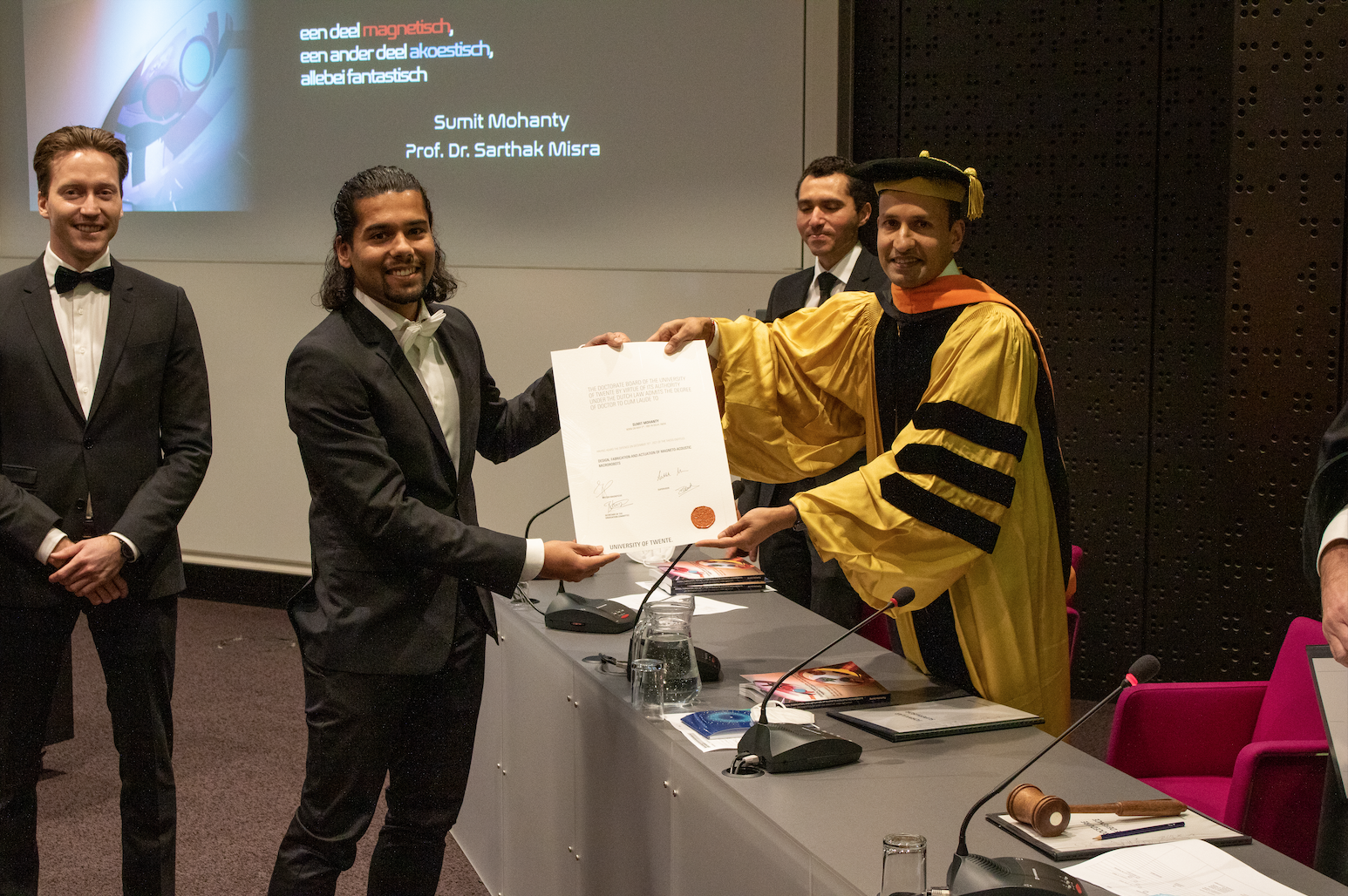 effector to a robotic manipulator is demonstrated (Chapter 5). Subsequently, Part III entails design and actuation of acoustically-powered autonomous microrobots that move under combined guidance of acoustic and magnetic fields. Bubbles are introduced as means to harness acoustic power that function as building blocks for different designs of acoustic microrobots. Three different designs of acoustic microrobots are presented where arrays of multiple bubbles vibrate to produce gear-like rotational motion (Chapter 6), and a bio-inspired pumping mechanism (Chapter 7). Thereon, this bubble-powered propulsion of microrobots is combined with magnetic steering to show the motion of microrobots under magneto-acoustic actuation. Lastly, Part IV provides conclusions and future research directions on the different approaches discussed in the three parts (Chapter 8). These research directions provide outlook on how the microrobotic technologies entailed in this thesis (Chapter 2-7) can mutually collaborate towards their potential applications.
effector to a robotic manipulator is demonstrated (Chapter 5). Subsequently, Part III entails design and actuation of acoustically-powered autonomous microrobots that move under combined guidance of acoustic and magnetic fields. Bubbles are introduced as means to harness acoustic power that function as building blocks for different designs of acoustic microrobots. Three different designs of acoustic microrobots are presented where arrays of multiple bubbles vibrate to produce gear-like rotational motion (Chapter 6), and a bio-inspired pumping mechanism (Chapter 7). Thereon, this bubble-powered propulsion of microrobots is combined with magnetic steering to show the motion of microrobots under magneto-acoustic actuation. Lastly, Part IV provides conclusions and future research directions on the different approaches discussed in the three parts (Chapter 8). These research directions provide outlook on how the microrobotic technologies entailed in this thesis (Chapter 2-7) can mutually collaborate towards their potential applications.
Promotor
- Prof. Dr. S. Misra (University of Twente/University Medical Center Groningen, The Netherlands)
Thesis Committee
- Prof. Dr. Ir. H. F. J. M. Koopman (University of Twente, The Netherlands) – Chair
- Dr. I. S. M. Khalil (University of Twente, The Netherlands) – Co-supervisor
- Prof. Dr. B. J. Nelson (Swiss Federal Institute of Technology Zurich, Switzerland)
- Prof. Dr. P. R. Onck (University of Groningen, The Netherlands)
- Prof. Dr. M. Versluis (University of Twente, The Netherlands)
- Prof. Dr. J. C. T. Eijkel (University of Twente, The Netherlands)
- Dr. J. Rouwkema (University of Twente, The Netherlands)

